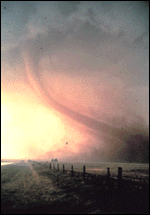Tornado Season

Tornadoes can occur at any time of the year.
In southern states, peak tornado occurrence is March through May, while peak months in northern states are during the summer.
Tornadoes are most likely between 3 and 9 p.m. but have occurred at all hours.
Watches Versus Warnings
Many confuse the meaning of a tornado "watch" and tornado "warning" when they are issued by the National Weather Service.
Watch : Tornadoes are possible in your area. Remain alert for approaching storms.
Warning : A tornado has been sighted or indicated by weather radar. If a tornado warning is issued for your area and the sky becomes threatening, move to a pre-designated place of safety.
Fujita Tornado Intensity Scale
 F0: Gale tornado (40 - 72 mph). Light damage.
F0: Gale tornado (40 - 72 mph). Light damage.- F1: Moderate tornado (73 - 112 mph). Moderate damage.
- F2: Significant tornado (113 - 157 mph). Considerable damage.
- F3: Severe tornado (158 - 206 mph). Severe damage.
- F4: Devastating tornado (207 - 260 mph). Devastating damage.
- F5: Incredible tornado (26 1- 318 mph). Incredible damage.
About 70 percent of tornadoes are weak and last between one and 10 minutes.
About 10 percent of tornadoes are strong and last 20 minutes or more.
Only two percent of tornadoes are considered violent. They cause the most deaths and can last for well over an hour.
Safety and Preparedness
It's important to remain alert to signs of an approaching tornado and seek shelter if threatening conditions exist.
Look for environmental clues including a dark sky, large hail or a loud roar.
If a warning is issued, move to a pre-designated shelter, such as a basement. Stay away from windows. Get out of automobiles and lie flat in a ditch or depression.
Do not try to outrun a tornado in your car.



